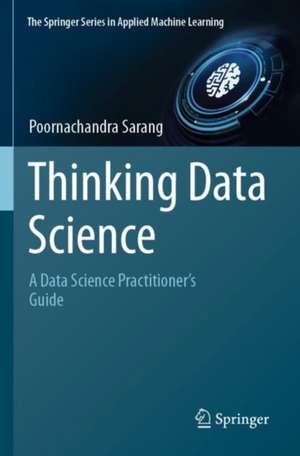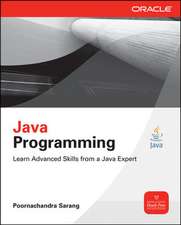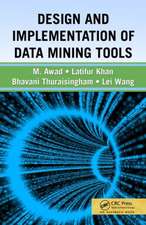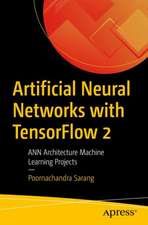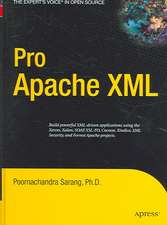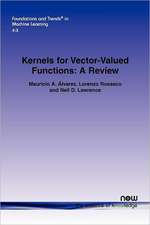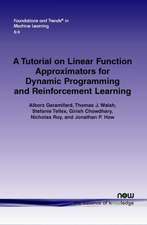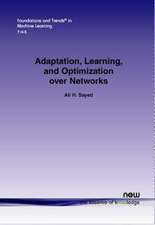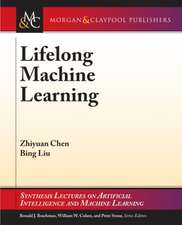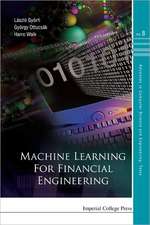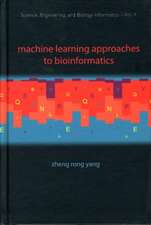Thinking Data Science: A Data Science Practitioner’s Guide: The Springer Series in Applied Machine Learning
Autor Poornachandra Sarangen Limba Engleză Paperback – 2 mar 2024
The challenge for a data scientist is to extract meaningful information from huge datasets that will help to create better strategies for businesses. Many Machine Learning algorithms and Neural Networks are designed to do analytics on such datasets. For a data scientist, it is a daunting decision as to which algorithm to use for a given dataset. Although there is no single answer to this question, a systematic approach to problem solving is necessary. This book describes the various ML algorithms conceptually and defines/discusses a process in the selection of ML/DL models. The consolidation of available algorithms and techniques for designing efficient ML models is the key aspect of this book. Thinking Data Science will help practising data scientists, academicians, researchers, and students who want to build ML models using the appropriate algorithms and architectures, whether the data be small or big.
| Toate formatele și edițiile | Preț | Express |
|---|---|---|
| Paperback (1) | 366.99 lei 38-44 zile | |
| Springer International Publishing – 2 mar 2024 | 366.99 lei 38-44 zile | |
| Hardback (1) | 373.78 lei 3-5 săpt. | +30.63 lei 10-14 zile |
| Springer International Publishing – 2 mar 2023 | 373.78 lei 3-5 săpt. | +30.63 lei 10-14 zile |
Preț: 366.99 lei
Preț vechi: 458.73 lei
-20% Nou
Puncte Express: 550
Preț estimativ în valută:
70.22€ • 73.52$ • 58.11£
70.22€ • 73.52$ • 58.11£
Carte tipărită la comandă
Livrare economică 01-07 aprilie
Preluare comenzi: 021 569.72.76
Specificații
ISBN-13: 9783031023651
ISBN-10: 303102365X
Pagini: 358
Ilustrații: XX, 358 p. 233 illus., 132 illus. in color.
Dimensiuni: 155 x 235 mm
Ediția:2023
Editura: Springer International Publishing
Colecția Springer
Seria The Springer Series in Applied Machine Learning
Locul publicării:Cham, Switzerland
ISBN-10: 303102365X
Pagini: 358
Ilustrații: XX, 358 p. 233 illus., 132 illus. in color.
Dimensiuni: 155 x 235 mm
Ediția:2023
Editura: Springer International Publishing
Colecția Springer
Seria The Springer Series in Applied Machine Learning
Locul publicării:Cham, Switzerland
Cuprins
Chapter. 1. Data Science Process.- Chapter. 2. Dimensionality Reduction - Creating Manageable Training Datasets.- Chapter. 3. Classical Algorithms - Over-view.- Chapter. 4. Regression Analysis.- Chapter. 5. Decision Tree.- Chapter. 6. Ensemble - Bagging and Boosting.- Chapter. 7. K-Nearest Neighbors.- Chapter. 8. Naive Bayes.- Chapter. 9. Support Vector Machines: A supervised learning algorithm for Classification and Regression.- Chapter. 10. Clustering Overview.- Chapter. 11. Centroid-based Clustering.- Chapter. 12. Connectivity-based Clustering.- Chapter. 13. Gaussian Mixture Model.- Chapter. 14. Density-based.- Chapter. 15.- BIRCH.- Chapter. 16. CLARANS.- Chapter. 17. Affinity Propagation Clustering.- Chapter. 18. STING.- Chapter. 19. CLIQUE.- Chapter. 20. Artificial Neural Networks.- Chapter. 21. ANN-based Applications.- Chapter. 22. Automated Tools.- Chapter. 23. DataScientist’s Ultimate Workflow.
Notă biografică
Poornachandra Sarang, in his IT career spanning four decades, has been consulting large IT organizations on the design and architecture of systems using state-of-the-art technologies. He has authored several books covering a wide range of emerging technologies. Dr. Sarang is a Ph.D. advisor for Computer Science and Engineering and is on the thesis advisory committee for aspiring doctoral candidates. He has designed and delivered courses/curricula for universities at the postgraduate level, including courses and workshops on emerging technologies for industry. He is a known face at technical and research conferences delivering both keynote and technical talks.
Textul de pe ultima copertă
This definitive guide to Machine Learning projects answers the problems an aspiring or experienced data scientist frequently has: Confused on what technology to use for your ML development? Should I use GOFAI, ANN/DNN or Transfer Learning? Can I rely on AutoML for model development? What if the client provides me Gig and Terabytes of data for developing analytic models? How do I handle high-frequency dynamic datasets? This book provides the practitioner with a consolidation of the entire data science process in a single “Cheat Sheet”.
The challenge for a data scientist is to extract meaningful information from huge datasets that will help to create better strategies for businesses. Many Machine Learning algorithms and Neural Networks are designed to do analytics on such datasets. For a data scientist, it is a daunting decision as to which algorithm to use for a given dataset. Although there is no single answer to this question, a systematic approach to problem solving is necessary. This book describes the various ML algorithms conceptually and defines/discusses a process in the selection of ML/DL models. The consolidation of available algorithms and techniques for designing efficient ML models is the key aspect of this book. Thinking Data Science will help practising data scientists, academicians, researchers, and students who want to build ML models using the appropriate algorithms and architectures, whether the data be small or big.
The challenge for a data scientist is to extract meaningful information from huge datasets that will help to create better strategies for businesses. Many Machine Learning algorithms and Neural Networks are designed to do analytics on such datasets. For a data scientist, it is a daunting decision as to which algorithm to use for a given dataset. Although there is no single answer to this question, a systematic approach to problem solving is necessary. This book describes the various ML algorithms conceptually and defines/discusses a process in the selection of ML/DL models. The consolidation of available algorithms and techniques for designing efficient ML models is the key aspect of this book. Thinking Data Science will help practising data scientists, academicians, researchers, and students who want to build ML models using the appropriate algorithms and architectures, whether the data be small or big.
Caracteristici
Written for both aspiring and working data scientists to develop and improve their AI applications Teaches how to handle numeric, text and image datasets, GOFAI and ANN/DNN development, and use automated tools Includes a large section on clustering algorithms, explaining their applications for various sized datasets
